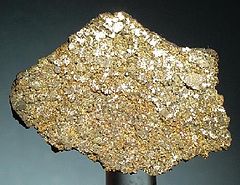| H chondrite | |
|---|---|
| — Group — | |
 Weston meteorite, H4 | |
| Type | Chondrite |
| Structural classification | ? |
| Class | Ordinary chondrite |
| Subgroups |
|
| Parent body | Possibly 6 Hebe, less likely 3 Juno & 7 Iris |
| Composition | Iron ~25–31%, bronzite (an orthopyroxene), olivine (with characteristic fayalite (Fa) content 16 to 20 mol%), nickel-iron 15–19%, troilite 5% |
| Petrologic type | 3 (~2.5%), 5 (40%), 4 & 6 (57.5%) |
| Alternative names | Bronzite chondrites, Olivine bronzite chondrites |
 Nuevo Mercurio, H5 | |
The H type ordinary chondrites are the most common type of meteorite, accounting for approximately 40% of all those catalogued, 46% of the ordinary chondrites, and 44% of all chondrites.[1] The ordinary chondrites are thought to have originated from three parent asteroids, whose fragments make up the H chondrite, L chondrite and LL chondrite groups respectively.[2]
- ^ "Natural History Museum, meteorite catalogue". Archived from the original on 2006-05-03. Retrieved 2005-11-29.
- ^ NASA (YouTube) – Dr. David Kring – Asteroid Initiative Workshop Cosmic Explorations Speakers Session